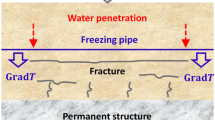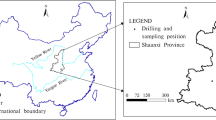Abstract
Purpose
Soils in Qinghai-Tibet Plateau are expected to undergo freeze-thaw cycles (FTCs) with higher frequencies and larger amplitudes due to global climate change. Our objective was to ascertain the effect of FTCs on the pore structure of soil aggregates of different diameters during successive FTCs.
Materials and methods
In this study, we measured the effects of FTCs on interior and exterior pore structure of soil aggregates of different diameters (0.25–1 mm, 1–2 mm, 2–3 mm and 3–5 mm) from the northeastern Qinghai-Tibet Plateau (0–10 cm) through X-ray computed tomography (CT) scanning. The FTC experiment was performed in the laboratory and consisted of 10 FTCs (freezing -10 °C and thawing 20 °C).
Results and discussion
The porosity (> 5 µm) of soil aggregates first decreased and then increased during successive FTCs, and the volumes of soil aggregates increased during successive FTCs. The changes in porosity (FTC0 → FTC3 and FTC0 → FTC5) were significantly positively correlated with the contents of SOC. Small aggregates were less sensitive to successive FTCs and large aggregates (3–5 mm) with low SOC were more sensitive to successive FTCs. FTCs altered the exterior pore size distribution of aggregates, and decreased the exterior microporosity (5–30 μm) and mesoporosity (30–80 μm) and increased the exterior macroporosity (> 80 μm). In contrast, there were no significant differences in the interior porosities of aggregates during successive FTCs.
Conclusions
FTCs affected the pore structure of soil aggregates remarkably, especially 3–5 mm aggregate and the exterior pores of aggregates. The porosity of aggregates increased after frequent FTCs.







Similar content being viewed by others
Data availability
The data that support the findings of this study are available from the corresponding author upon reasonable request.
References
Ananyeva K, Wang W, Smucker AJM, Rivers ML, Kravchenko AN (2013) Can intra-aggregate pore structures affect the aggregate’s effectiveness in protecting carbon? Soil Tillage Res 57:868–875. https://doi.org/10.1016/j.soilbio.2012.10.019
Bach EM, Williams RJ, Hargreaves SK, Yang F, Hofmockel KS (2018) Greatest soil microbial diversity found in micro-habitats. Soil Biol Biochem 118:217–226. https://doi.org/10.1016/j.soilbio.2017.12.018
Chen H, Ju P, Zhu Q, Xu X, Wu N, Gao Y, Feng X, Tian J, Niu S, Zhang Y, Peng C, Wang Y (2022) Carbon and nitrogen cycling on the Qinghai-Tibetan Plateau. Nat Rev Earth Environ 3:701–716. https://doi.org/10.1038/s43017-022-00344-2
FEI (2016) Amira & Avizo 3D software. https://www.fei.com/software/amira-avizo/. Accessed 1 Mar 2017
Gao Z, Hu X, Li XY, Li ZC (2020) Effects of freeze-thaw cycles on soil macropores and its implications on formation of hummocks in alpine meadows in the Qinghai Lake watershed, northeastern Qinghai-Tibet Plateau. J Soils Sediments 21:245–256. https://doi.org/10.1007/s11368-020-02765-2
Harvey HJ, Wildman RD, Mooney SJ, Avery SV (2020) Soil aggregates by design: manufactured aggregates with defined microbial composition for interrogating microbial activities in soil microhabitats. Soil Biol Biochem 148:107870. https://doi.org/10.1016/j.soilbio.2020.107870
Hu GR, Li XY, Yang XF (2020) The impact of micro-topography on the interplay of critical zone architecture and hydrological processes at the hillslope scale: Integrated geophysical and hydrological experiments on the Qinghai-Tibet Plateau. J Hydrol 583:124618. https://doi.org/10.1016/j.jhydrol.2020.124618
Huang CY, Xu JM (2010) Soil, 3rd edn. China, Beijing
IUSS Working Group WRB (2015) World reference base for soil resources 2014, update 2015: International soil classification system for naming soils and creating legends for soil maps World Soil Resources Reports No. 106. FAO, Rome
Jasinska E, Baumgartl T, Wetzel H, Horn R (2006) Heterogeneity of physicochemical properties in structured soils and its consequences. Pedosphere 16(3):284–296. https://doi.org/10.1016/S1002-0160(06)60054-4
Klute A (1986) Methods of soil analysis: part 1 – physical and mineralogical methods, 2nd edn. American Society of Agronomy, Madison (Agronomy 9)
Kravchenko AN, Negassa WC, Guber AK, Rivers ML (2015) Protection of soil carbon within macro-aggregates depends on intra-aggregate pore characteristics. Sci Rep 5:16261. https://doi.org/10.1038/srep16261
Lal R, Shukla MK (2004) Principles of Soil Physics. Marcel Dekker, New York
Li GY, Fan HM (2014) Effect of freeze-thaw on water stability of aggregates in a black soil of northeast China. Pedosphere 24(2):285–290. https://doi.org/10.1016/S1002-0160(14)60015-1
Li XY, Yang XF, Ma YJ, Hu GR, Hu X, Wu XC, Wang P, Huang YM, Cui BL, Wei JQ (2018) Qinghai Lake Basin critical zone observatory on the Qinghai-Tibet Plateau. Vadose Zone J 17:1–11. https://doi.org/10.2136/vzj2018.04.0069
Liang AZ, Zhang Y, Zhang XP, Yang XM, McLaughlin NB, Chen XW, Guo YF, Jia SX, Zhang SX, Wang LX, Tang JW (2019) Investigations of relationships among aggregate pore structure, microbial biomass, and soil organic carbon in a Mollisol using combined non-destructive measurements and phospholipid fatty acid analysis. Soil Tillage Res 185:94–101. https://doi.org/10.1016/j.still.2018.09.003
Liu B, Ma RM, Fan HM (2021) Evaluation of the impact of freeze-thaw cycles on pore structure characteristics of black soil using X-ray computed tomography. Soil Tillage Res 206:104810. https://doi.org/10.1016/j.still.2020.104810
Liu M, Han GL, Zhang Q (2019) Effects of soil aggregate stability on soil organic carbon and nitrogen under land use change in an erodible region in southwest China. Int J Environ Res Public Health 16:3809. https://doi.org/10.3390/ijerph16203809
Liu X, Wang Q, Qi Z, Han JG, Li LH (2016) Response of N2O emissions to biochar amendment in a cultivated sandy loam soil during freeze-thaw cycles. Sci Rep 6:35411. https://doi.org/10.1038/srep35411
Lu JG, Zhang MY, Zhang XY, Pei WS, Bi J (2018) Experimental study on the freezing–thawing deformation of a silty clay. Cold Reg Sci Technol 151:19–27. https://doi.org/10.1016/j.coldregions.2018.0
Ma RM, Jiang Y, Liu B, Fan HM (2021) Effects of pore structure characterized by synchrotron-based micro-computed tomography on aggregate stability of black soil under freeze-thaw cycles. Soil Tillage Res 207:104855. https://doi.org/10.1016/j.still.2020.104855
Menon M, Mawodza T, Rabbani A, Blaud A, Lair GJ, Babaei M, Kercheva M, Rousseva S, Banwart S (2020) Pore system characteristics of soil aggregates and their relevance to aggregate stability. Geoderma 366:114259. https://doi.org/10.1016/j.geoderma.2020.114259
Mummey DL, Stahl PD (2004) Analysis of soil whole- and inner-microaggregate bacterial communities. Microb Ecol 48:41–50. https://doi.org/10.1007/s00248-003-1000-4
Pella E, Colombo B (1973) Study of carbon, hydrogen and nitrogen determination by combustion-gas chromatography. Mikrochim Acta 61:697–719. https://doi.org/10.1007/BF01218130
Rabot E, Wiesmeier M, Schlüter S, Vogel HJ (2018) Soil structure as an indicator of soil functions: a review. Geoderma 314:122–137. https://doi.org/10.1016/j.geoderma.2017.11.009
Rooney EC, Bailey VL, Patel KF, Dragila M, Battu AK, Buchko AC, Gallo AC, Hatten J, Possinger AR, Qafoku O, Reno LR, SanClements M, Varga T, Lybrand RA (2022) Soil pore network response to freeze-thaw cycles in permafrost aggregates. Geoderma 411:115674. https://doi.org/10.1016/j.geoderma.2021.115674
Sexstone AJ, Revsbech NP, Parkin TB, Tiedje JM (1985) Direct measurement of oxygen profiles and denitrification rates in soil aggregates. Soil Sci Soc Am J 49(3):645–651. https://doi.org/10.2136/sssaj1985.03615995004900030024x
Shen JJ, Wang Q, Chen YT, Han Y, Zhang XD, Liu YW (2022) Evolution process of the microstructure of saline soil with different compaction degrees during freeze-thaw cycles. Eng Geol 304:106699. https://doi.org/10.1016/j.enggeo.2022.106699
Six J, Bossuyt H, Degryze S, Denef K (2004) A history of research on the link between (micro) aggregates, soil biota, and soil organic matter dynamics. Soil Tillage Res 79(1):7–31. https://doi.org/10.1016/j.still.2004.03.008
Strong DT, De Wever H, Merckx R, Recous S (2004) Spatial location of carbon decomposition in the soil pore system. Eur J Soil Sci 4:739–750. https://doi.org/10.1111/j.1365-2389.2004.00639.x
Wanzek T, Keiluweit M, Varga T, Lindsley A, Nico PS, Fendorf S, Kleber M (2018) The ability of soil pore network metrics to predict redox dynamics is scale dependent. Soil Syst 2(4):66. https://doi.org/10.3390/soilsystems2040066
Wu H, Li J, Li X, He B, Liu J, Jiang Z, Zhang C (2018) Contrasting response of coexisting plant’s water-use patterns to experimental precipitation manipulation in an alpine grassland community of Qinghai Lake watershed, China. PloS one 13(4):e0194242. https://doi.org/10.1371/journal.pone.0194242
Wuddivira MN, Camps-Roach G (2007) Effects of organic matter and calcium on soil structural stability. Eur J Soil Sci 58(3):722–727
Xia Q, Zheng NG, Heitman JL, Shi W (2022) Soil pore size distribution shaped not only compositions but also networks of the soil microbial community. Appl Soil Ecol 170:104273. https://doi.org/10.1016/j.apsoil.2021.104273
Xie SB, Qu JJ, Lai YM, Zhou ZW, Xu XT (2015) Effects of freeze-thaw cycles on soil mechanical and physical properties in the Qinghai-Tibet Plateau. J Mt Sci 12:999–1009. https://doi.org/10.1007/s11629-014-3384-7
Yang ZG, Hu X, Li XY, Gao Z, Zhao YD (2021) Soil macropore networks derived from X-ray computed tomography in response to typical thaw slumps in Qinghai-Tibetan Plateau, China. J Soils Sediments 21:2845–2854. https://doi.org/10.1007/s11368-021-02983-2
Yao TD, Bolch T, Chen DL, Gao J, Immerzeel W, Piao S, Su FG, Thompson L, Wada Y, Wang L, Wang T, Wu GJ, Xu BQ, Yang W, Zhang GQ, Zhao P (2022) The imbalance of the Asian water tower. Nat Rev Earth Environ 3:618–632. https://doi.org/10.1038/s43017-022-00299-4
Zhang Z, Ma W, Feng W, Xiao D, Hou X (2016) Reconstruction of soil particle composition during freeze-thaw cycling: a review. Pedosphere 26(2):167–179. https://doi.org/10.1016/S1002-0160(15)60033-9
Zhao YD, Hu X (2022) How do freeze-thaw cycles affect the soil pore structure in alpine meadows considering soil aggregate and soil column scales? J Soil Sci Plant Nutr. https://doi.org/10.1007/s42729-022-01019-z
Zhao YD, Hu X, Li XY (2020) Analysis of the intra-aggregate pore structures in three soil types using X-ray computed tomography. Catena 193:104622. https://doi.org/10.1016/j.catena.2020.104622
Zhao YD, Hu X, Li XY, Jiang LB, Gao Z (2021) Evaluation of the impact of freeze-thaw cycles on the soil pore structure of alpine meadows using X-ray computed tomography. Soil Sci Soc Am J 85(4):1060–1072. https://doi.org/10.1002/saj2.20256
Zhou H, Peng XH, Perfect E, Xiao TQ, Peng GY (2013) Effects of organic and inorganic fertilization on soil aggregation in an Ultisol as characterized by synchrotron based X-ray micro-computed tomography. Geoderma 195:23–30. https://doi.org/10.1016/j.geoderma.2012.11.003
Funding
This study was financially supported by the National Natural Science Foundation of China (Grant number: 41971053) and the Project Supported by State Key Laboratory of Earth Surface Processes and Resource Ecology (2022-TS-03).
Author information
Authors and Affiliations
Corresponding author
Ethics declarations
Conflict of interest
The authors declare no conflict of interest.
Additional information
Responsible editor: Jun Zhou
Publisher's Note
Springer Nature remains neutral with regard to jurisdictional claims in published maps and institutional affiliations.
Supplementary Information
Below is the link to the electronic supplementary material.
Rights and permissions
Springer Nature or its licensor (e.g. a society or other partner) holds exclusive rights to this article under a publishing agreement with the author(s) or other rightsholder(s); author self-archiving of the accepted manuscript version of this article is solely governed by the terms of such publishing agreement and applicable law.
About this article
Cite this article
Zhao, YD., Hu, X. A pore-scale investigation of soil aggregate structure responding to freeze-thaw cycles using X-ray computed microtomography. J Soils Sediments 23, 3137–3148 (2023). https://doi.org/10.1007/s11368-023-03539-2
Received:
Accepted:
Published:
Issue Date:
DOI: https://doi.org/10.1007/s11368-023-03539-2




